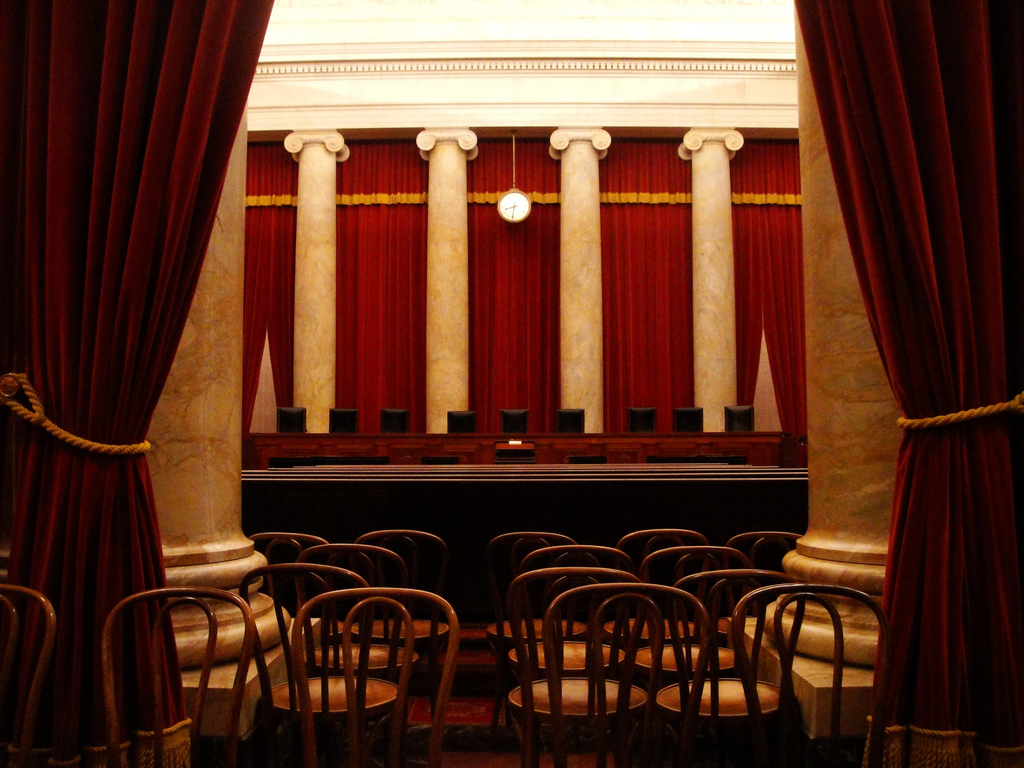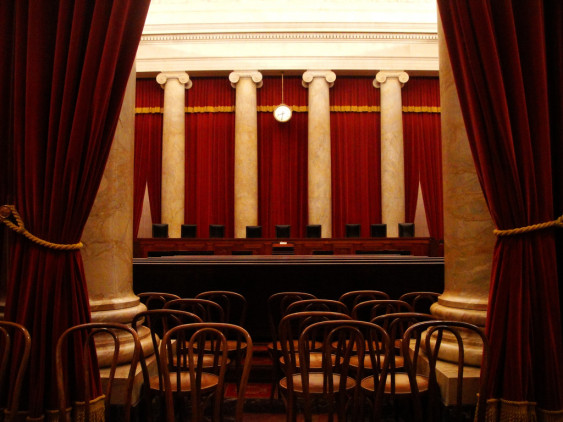The Cascadian states of Oregon and Washington are moving to empower people to vote rather than to stop them. Perhaps a next step for states aiming to serve as bastions of voting rights would be to start momentum towards a federal right to vote.
On Monday, the Supreme Court of the United States handed down a stunning but predictable decision in Husted v. Randolph, the case about the state of Ohio purging thousands of voters from the voter rolls. Stunning because it gives state legislatures unprecedented powers to prevent eligible voters from voting. Predictable because, contrary to popular assumption, the US Constitution actually does not guarantee citizens a right to vote. Freedom of speech and religion? Check. Right to bear arms? Roger. But not voting.
The result of this rather important omission from the Bill of Rights is that the Supreme Court does not carefully scrutinize cases where states stomp on voters’ rights in the same way the Court investigates state infringements on free speech or guns.
In a matter of years, the state of Ohio purged millions of voters from the state’s voter rolls. Ohio has already started the purge process for 4 million voters—fully half the voters in the state—because they did not vote in the 2010 mid-terms. (Voter turnout in the United States is consistently dismal, in part due to outdated electoral methods). Every purged person was a citizen who had registered to vote. Thousands of purged voters showed up at the polls to vote in 2016, only to find, to their surprise, they were not on the voter rolls. Not only was this distressing for the purged voters, the resulting confusion lengthened waits at the polls for all Ohio voters, possibly causing additional voters to give up and not vote. But the Court did not ask whether Ohio’s program unnecessarily violated voters’ rights. No. Instead the Court’s decision asked only whether Ohio violated the letter of a federal law.
The National Voter Registration Act of 1993 forbids states from removing someone from the voter rolls “by reason of the person’s failure to vote.” Another section of the law says no one may be removed “solely by reason of a failure to vote.” The state of Ohio argued that it was not removing voters from the rolls solely because of the person’s failure to vote, but rather because of their failure to vote and their failure to return a card asking them whether they had moved. The five conservative members of the Court agreed with Ohio. The decision gives all states the green light to remove eligible voters from the voter rolls if they fail to vote and fail to return a card. Indeed, a dozen other states have already said they plan to adopt Ohio’s voter purging practices.
Justice Thomas wrote a concurring opinion emphasizing that states have the exclusive authority to decide who gets to vote and who does not (because the Constitution does not protect voters from states potentially capricious or discriminatory rules). If a state decides that someone who hasn’t voted and hasn’t returned a card doesn’t qualify as a voter, the courts uphold the state’s right to exclude that person from voting. Compare that to free speech or guns, where the courts would protect citizens’ constitutional rights against states who infringe on those rights without extremely good reason (I’ll talk more below about the legal test where constitutional rights are concerned).
The conservative majority was unmoved by Justice Breyer’s dissent (joined by Justices Ginsburg, Sotomayor, and Kagan) pointing out that the National Voter Registration Act’s Failure-to-Vote Clause was written specifically to prevent states from removing voters from the rolls because they didn’t vote, yet Ohio is targeting people who didn’t vote and removing them from the rolls. The majority was unmoved by Justice Kagan’s separate dissent pointing out that Ohio’s program is the latest in a long line of state efforts to prevent people of color from voting, and Ohio’s program has “disproportionately affected minority, low-income, disabled, and veteran voters.”
The majority was unmoved because no American has a guaranteed right to vote—not people of color, not veterans, not people who skip an election—so Ohio doesn’t need to protect citizens’ right to vote, it only needs to comply with the letter of the federal law and send them a card before preventing them from voting.
Justice Alito closed his opinion by making this point: “We have no authority to . . . decide whether Ohio’s Supplemental Process is the ideal method for keeping its voting rolls up to date. The only question before us is whether it violates federal law. It does not.” In other words, because voting is not listed in the Constitution as a right, Ohio can cause as much collateral damage on voters as it wants in supposedly keeping its voter rolls up to date.
If voting were a Constitutional right, the Supreme Court would have struck down Ohio’s actions. If Americans had a fundamental right to vote, the only way Ohio would have been able to defend its anti-voter program would have been to prove two things (in legalese, this is the “strict scrutiny” test):
- The state had a compelling interest—the goal the state is trying to accomplish is necessary or crucial, not just something the state preferred to do.
- The policy was narrowly tailored and the least restrictive means of achieving that interest—there is no way the state could infringe less on citizens’ rights and still achieve its crucial goal.
Ohio might have been able to argue it had a compelling interest in preventing voter fraud by clearing people from the voter rolls if they no longer lived there. (Even though more people get hit by lightning than commit voter fraud).
But Ohio could not have passed the laugh test in arguing that removing voters who had skipped a few elections was narrowly tailored to protecting the state from voter fraud. As Justice Breyer pointed out in his dissenting opinion, only 4 percent of Americans move outside their county each year. Ohio has about 9 million voting age residents, so about 360,000 of them might be expected to move in an average year. Of those, Ohio said at least 60 percent notify the Post Office and Ohio removes them from the rolls. Some additional number change their address with the Department of Motor Vehicles and their voting record gets updated too. That leaves at most about 140,000 voting age residents who may have moved without notice each year. But Ohio’s program purged an order of magnitude more than that—a whopping 1.5 million voters—in a single year. The “narrowly tailored” legal test is all about making sure the state only cuts the amount it really needs from the cloth, without unnecessary waste. Ohio took the whole bolt of cloth and threw it in a dumpster.
Another thing courts look at when states are violating citizens’ rights is whether that is the “least restrictive” way—the way that infringes the least on citizens’ rights—that the state can pursue crucially important goals. Purging more than a million eligible voters from voting is certainly not the least restrictive means of keeping clean voter rolls. No, that would be the Electronic Registration Information Center (ERIC), of which Ohio and 22 other states are already members. ERIC compares voter registration information between its member states as well as against motor vehicle licensing agency data and the Social Security Administration death index to remove duplicate records, update voter records when people move, and remove them from the voter rolls when they die. In other words, the database cross-references data to keep voter rolls clean and eliminate the (miniscule, nearly non-existent) possibility of in-person voter fraud.
Ohio’s Secretary of State claims the state’s goal is to “make it easy to vote and hard to cheat.” Sounds good. Ohio is already using ERIC to make it hard to cheat. They could follow Oregon and Washington’s lead and use vote-at-home and automatic voter registration to make it easy to vote. (By the way, it’s much cheaper for state to enable voters than to suppress them, as Oregon and other vote-at-home states have found). Preventing people from voting when they skip a few elections doesn’t really factor in.
Fortunately, the Cascadian states of Oregon and Washington are moving to empower people to vote rather than to stop them. Perhaps a next step for states aiming to serve as bastions of voting rights would be to start momentum towards a federal right to vote. Oregon and Washington could enshrine the right to vote in their state constitutions and start the long process of amending the US Constitution to take a final step in the long journey toward giving all citizens the right to vote.












Gerry Langeler
A few other thoughts in this direction: The three current 100% “Vote at Home” – VAH states (CO, OR, WA) also have linked up with the USPS National Change of Address (NCOA) system. Once a month, they get a fresh copy of that database and automatically move the voter’s registration to their new address. Then, they send a postcard telling the voter that the registration has been moved, allowing them to again “opt-out” if that was not their intent.
This is the exact opposite of the “opt-in” model in Ohio where you have to answer the postcard to NOT be dropped. Utah is now at 98% VAH. North Dakota has 31 of 53 counties voting that way, as do over 1000 precincts in MN. In this week’s ND primary, every county with VAH had higher turnout than even the highest traditional polling place county there. California just went to 100% VAH in five counties this month, and while ballots are still being processed it appears the turnout in those counties will be materially higher than four years ago.
Much more on making voting more accessible at voteathome.org
Steve Erickson
The state by state constitutional voting rights amendment is probably the best way to build towards a federal constitutional amendment. However, we can assume that the so-called “republicans” currently controlling major portions of the country will quickly adopt laws to disenfranchise enough contrary voters so that, combined with gerrymandering, they will essentially have a long term well nigh permanent lock on controlling those state governments. And the people in those states will have absolutely no recourse unless the Supreme Court steps in (unlikely) or Congress changes the law, equally unlikely because this political coupe will create a self-sustaining feedback loop assuring that their congress critters (as Jim Hightower calls them) will be of the proper political complexion. Frankly, I think it will take another revolution for the US to truly become a democracy.
Gina Wright
This article makes me want to give up all hope for democracy… There is no democracy when this goes on. What democracy?We are culling the herds of voters. Is this what our forefathers wanted,this kind of illegitimate democracy?… I think it is. I think it is.I want to cry.